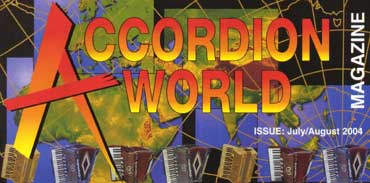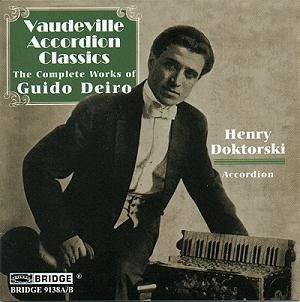
The review was written by Peter Ayres and is presented here by the permission of Accordion World.
(See our review of Accordion World Magazine) .

|
The following review was originally published in the July/August 2004 edition of Accordion World magazine (editor: David Keen). The review was written by Peter Ayres and is presented here by the permission of Accordion World. (See our review of Accordion World Magazine) . |

This 47 track CD, containing the complete works of Guido Deiro, is an important record of the pioneer accordionist described as inventor of the "piano-accordion, which is unique and novel as an instrument, something in the nature of a mammoth accordion with a piano keyboard." (Springfield Union - January 7, 1913) It is manufactured in San Francisco, he says, from a plan he drew while still in Rome". (Columbus Ledger- March 19, 1914) As early as 1913 he was described as "the world's greatest piano-accordionist".
We have much to thank Guido Deiro for raising the status of the instrument in those early days. He was the first to introduce the instrument on records, over the radio and in talking pictures. "Once the accordion was the instrument of the proletariat, and to confess a liking for accordion music was to betray exceedingly bad taste. Accordion players were discredited; why, they might even be second-story workers in disguise! What a change Deiro has wrought. He has made the accordion one of the most musical of instruments; one who can play it well is accepted as an artist, and there is no better evidence of discriminating taste than appreciation of such music as Deiro's." (News Clipping - San Antonio, Texas, ca. 1916-17)
Henry Doktorski is described as "one of the leading concert accordionists in the United States and a recognized figure in international classical accordion circles." After performing two of Guido Deiro's works at City University of New York in March 2001 he received a letter from Guido Deiro's only son, Count Guido Roberto Deiro, who was only a lad when his father passed away. It said, "It has been more than a half-century since I heard anyone play my father's music as well as you. Your command of the instrument almost exceeds its capabilities. More than that you demonstrate sensitivity and respect for what the composer was trying to say and you play with genuine feeling. I know my father would have been delighted with your renditions .... Believe me, no one has played his music as well as you did this evening."
The playing on this CD reflects this view expressed in Guido Deiro's son's letter. Henry Doktorski does have great control of the instrument and plays with sensitivity and genuine feeling. However, he plays a modern straight tuned high-quality Victoria accordion. It is very interesting to compare this with original Guido Deiro recordings (available on the Guido Deiro Website "www.guidodeiro.com") and Henry Doktorski playing Guido Deiro's 1924 Guerrini instrument on one of the tracks. A modern instrument with a cassotto tone chamber and multi registers sounds very different from the instrument that these pieces were written for. Although early acoustic recordings sound thin in tone, they tell us how the composer intended the pieces to be interpreted. The modern recording of the 1924 instrument gives us an accurate account of what its sound was like. It has a brighter sound when played full and the bass reeds are lighter. There is only one treble "coupler" to vary the tone. Consequently the sheet music would not have contained registration marks to assist in adding colour to the interpretation.
This CD could have been made on contemporary instruments, such as the 1924 Guerrini and later instruments such as the composer played, or it could have used a modern instrument, making creative use of multi registers, including those in the bass. Bearing in mind that Guido Deiro was a vaudeville artist who was part of a bill containing many types of act (ten to fifteen individual unrelated acts, featuring magicians, acrobats, comedians, trained animals, jugglers, singers, musicians and dancers), then to have recorded all items without the use of multi registers would have resulted in a degree of monotony. Henry Doktorski has avoided this by choosing an order that varies the style of each piece and also makes good use of changes of registration. Both CDs are over 70 minutes long and one needs to realise that the selection given would not be suitable for a concert programme because of the similarity of style and form. For instance, the first CD contains 7 marches, 5 waltzes, 2 rags, 2 polkas and 1 foxtrot, mazurka, tango and fantasia; and the second CD contains 9 marches, 9 waltzes, 3 foxtrots, 2 polkas and 1 rag, mazurka, tango and quadrille. They are mainly short pieces suited for an act in a variety show, as was American vaudeville. There is only one extended piece, such as his brother Pietro wrote (i.e. Tranquillo, Trieste, Imperia or the Concertos). This is Egypto Fantasia and is in descriptive oriental style, sensitively played with good use of tone colour. One wonders whether it was written before Tranquillo, Trieste and Imperia or whether this piece inspired Pietro to write these overtures. Also, was Bizet's "Carmen" theme heard near the end a deliberate inclusion?
Two 6/8 marches in similar vein to his brother's Pietro's Return and Preparedness March and Hand Grenade Throwers March. They are both given a stylish performance and contain a well-marked bass solo. In similar vein is one of the three pieces that I am familiar with, Sharpshooter's March, said to contain the first bass solo played on an accordion. This piece derives from an Italian march that Guido heard in Metz in 1907 played on a hand organ. He did not know its name and so called it Sharpshooters March. This was his first accordion recording and found that the title had been changed to Curro Cuchares by G. Metallo, as it was similar to this piece. The two different copies of the sheet music that I have are called Sharpshooters March, composed by G Metallo.
Other pieces that I particularly liked are: Pink Slippers Valse, played very sensitively and with good choice of registers as is Valse Caprice No 1 with good use of rubato; Royal Flying Corps March, a fast march played with style and dynamics, reminiscent of Frosini's The Jolly Caballero; Dolores Waltz, probably inspired by Johann Strauss. Tango Tosino, played with sensitivity and tonal contrast, as is the other tango Lido Tango; and II Pentimento Waltz, a slow expressive waltz that contains a section that similar to Ponchielli's Dance of The Hours, a piece that Guido probably knew well.
On the second CD sixteen of the pieces come from his Royal Method for Piano Accordion, published in 1936, of which Pietro Frosini said "I highly endorse this method." Most of the pieces are simple, suitable for the student learning the instrument, although they vary in difficulty, Sharpshooters March being one of these. I particularly liked The Accordion Girl Waltz, which is played expressively with good use of rubato.
Henry Doktorski is to be congratulated on this project and also for taking on the editing of the sheet music edition of Guido Deiro's complete works. which will be available later in the year. I am looking forward very much to obtaining my copy and playing these pieces myself. This will be a valuable addition to the accordion repertoire, absent for players in this country for too long a time.
Peter AyresNOTE: For another review of this CD, please go to Henry Doktorski: Vaudeville Accordion Classics
To purchase this CD go to:
http://henrydoktorski.com/order.html
| About The Free-Reed Review |
| Invitation to Contributors / Submission Guidelines |
| Back to The Free-Reed Review Contents
Page |
| Back
to The Classical Free-Reed, Inc. Home Page |